Abbreviations
Agg. = aggregate where a species is divided into a number of microspp.,
Natd = Naturalised,
BI = British Isles (including Ireland),
Br = Britain,
CI = Channel Islands,
N, S, E, W; C = points of compass; central
En = England,
Ire = Ireland,
Man = Isle of Man,
P = Phosphorus
Sc = Scotland
Wa = Wales
+/- = more or less
c. = approximately
cf. = compare
cv. = cultivar
esp. = especially
exc. = except
lf/lvs/fl = leaf/leaves/flower
lflet = leaflet (of compound leaf)
LHS/RHS = left hand side/right hand side
N.B. = note ('nota bene')
pic = picture/image
sm. = small
sp./spp. = species/species
subsp./subspp. = sub-species/sub-species
usu. = usually
Glossary
A B C D E F G H I/J/K L M/N O P/Q R S T U/V/W/X/Y/Z
A
Actinomorphic - Regular flowers (radially symmetrical)
Achene - Dry 1-seeded fruit
Alternate - Only one leaf at each insertion point on the stem (c.f. opposite)
Anther - Pollen containing body on 'filaments' in the flower
Apetalous - Without petals
Appressed - Appressed hairs lie flat on the surface
Apomictic - Plants that produce seed of wholly female origin - i.e. without fertilisation; these tend to diverge into many microspecies
Auricle - Lobe or extension at the basal end of a leaf
Awn - A bristle on the end of parts of grass flowers - see under "grass"
Axil - The leaf axil is the joint between a leaf petiole and the main stem
B
Basic soils are alkaline (often on chalk or limestone)
Beak - the top portion of fruits e.g. in Asteraceae, Brassicaceae
Bract - A much reduced, often scale-like leaf, usually subtending a flower or sometimes sepal-like around flower head of Asteraceae (=phyllary)
Bracteole - A secondary bract; also refers also to structures round fruits in Amaranthaceae
C
Calcareous - Calcareous soils are base-rich (alkaline) and usually based on chalk or limestone
Calyx - The outer whorl of the flower - usually distinguished from the coloured petals (the inner whorl)
Capitulum - The "flower" comprising many individual flowers in Asteraceae (Daisies and dandelions) and Dipsacaceae
Capsule - A dry fruit that often disperses many seeds
Carpels - The basic female reproductive unit (may be several in an ovary)
Clawed - Petals are 'clawed' where they narrow to a long stalk or claw at the base
Compound - A compound leaf is divided into leaflets by divisions down to midrib (see Palmate or Pinnate leaves)
Cordate - Leaves with a heart-shaped base
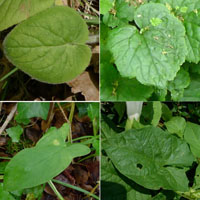
Corm - Short overwintering underground swollen stem (as in a crocus)
Corolla - The inner whorl of petals in a flower
Crenate - With rounded teeth
Culm - Stem of a grass
Cyathea - The glands opposite to the ovary in Euphorbiaceae, often horned
D
Decurrent - Usually refers to base of a leaf being extended down the stem as a ridge
Dicot - Higher plant whose seeds have two embryonic leaves or cotyledons - leaf veins are branching
Dichotomous - Dividing into two at each node
Dioecious - Male and female flowers on separate plants
E
Entire - Entire leaves are not divided, toothed or lobed so have +/- smooth edges (can have fine teeth)
Epicalyx - Extra apparent calyx outside the usual calyx
Epiphyte - A plant that grows on another (including lichens and parasites such as Mistletoe)
Exserted - Stamens are exserted if they stick out beyond the mouth of the flower
F
Filament - The stem of a stamen, holding up the anther
Free - Petals or speals are free if they are not joined at the base
Fruit - The ripe seeds and the surrounding structure (e.g. berry or nut)
Fused - e.g. where the separate petals are joined together in a single corolla
G
Glabrous - Hairless
Glandular - Glandular hairs have obvious blobs (glands) on them
Glaucous - Bluish-white in colour
Glume - The basal (or outer) bract, often membranous, sheathing each flower in sedges and grasses (see diagram below)
Grasses - "are hollow right down to the ground"
Expanded diagram of a grass spikelet (containing several florets):
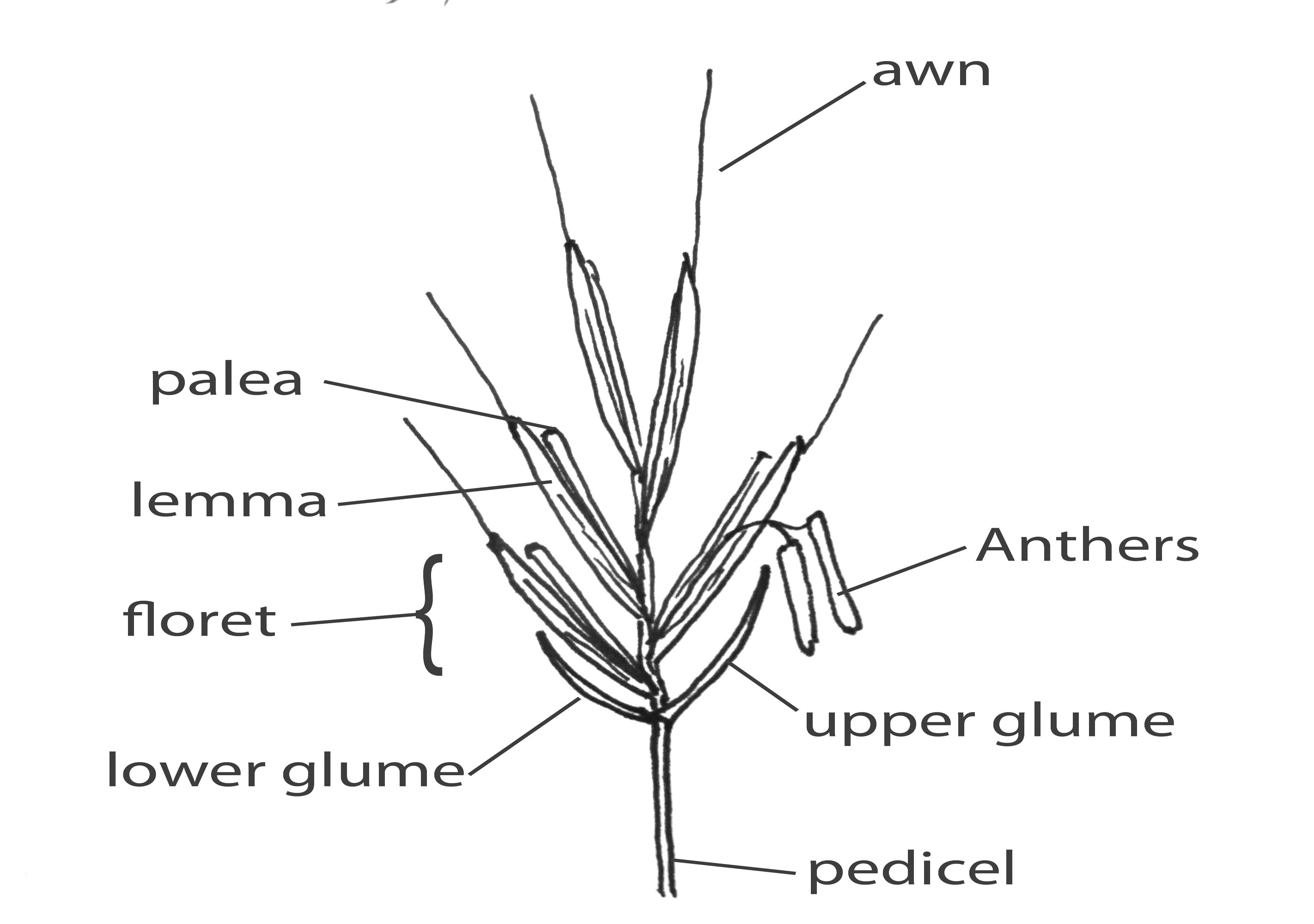
H
Hairs - Hairs vary from simple, to branched or stellate and may also have glands on them
Hastate - Leaves are 'halberd'-shaped
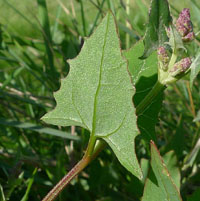
Herbaceous - not woody, often dying down each year
Hispid - Harsh or bristly hairs
I/J/K
Indusium - Flap of tissue covering spores in some ferns:
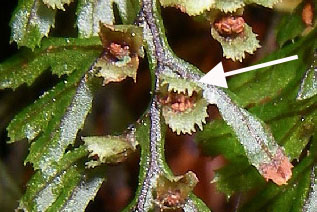
Inferior - Ovary and fruits develop below the calyx (e.g. rose)
Inflorescence - The flowering part of the stem including all flowers, bracts
Involucre - The whorl of bracts surrounding a flower head
"Iris-leaves" - Iris-like leaves are vertical and folded flat so have 2 identical surfaces:
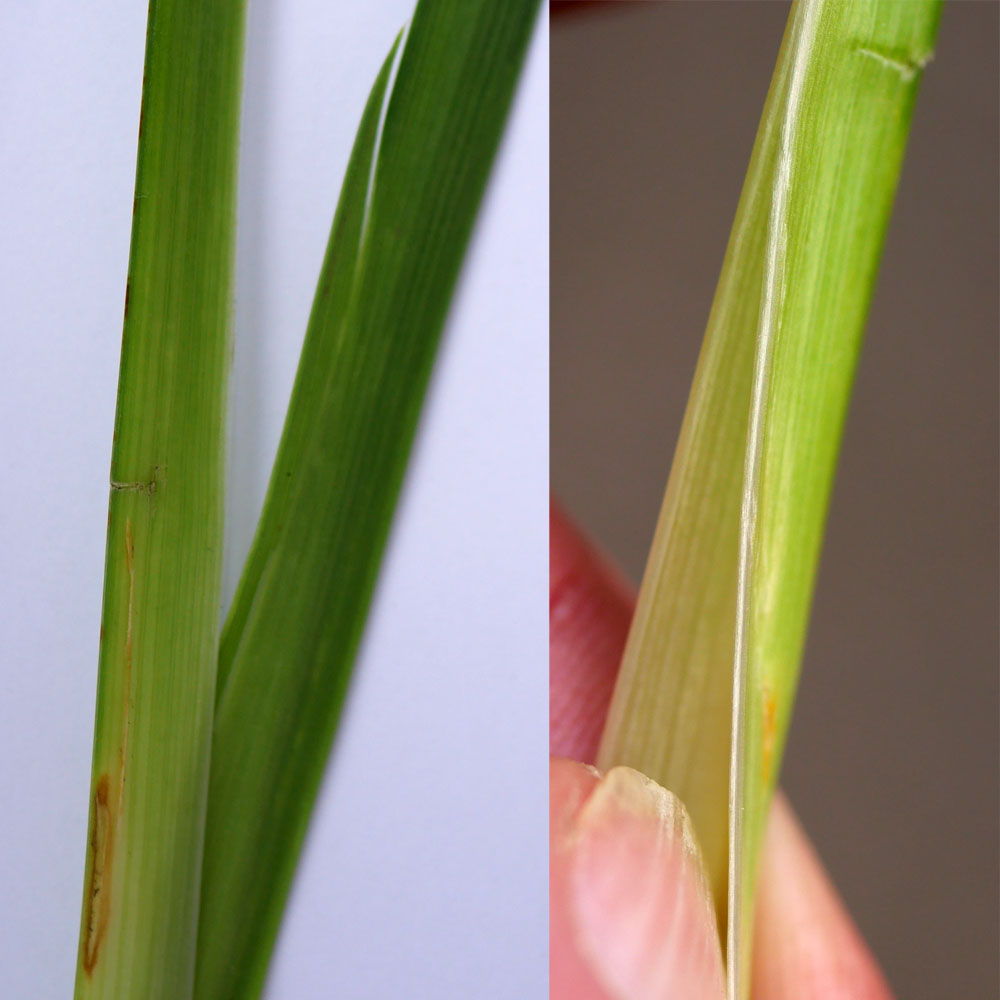
Irregular - Flowers are 'irregular' if they have petals of different size and shape and hence usually only 1 plane of symmetry (= 'zygomorphic')
Keel - The lower, boat-shaped, petal (actually 2 fused petals) of pea flowers (Fabaceae)
L
Labellum - Lower petal in Orchids
Lanceolate - Very narrowly oval leaves (long and thin, >6x as long as wide)
Lemma - the membranous outer part of each floret in a grass (See diagram under "Grass")
Lenticel - Small corky dot on surface esp. of bark
Ligule - A small flap at the junction of leaf and stem in grasses and sedges: these provide a key feature for separating plants with linear flat leaves:
Sedge: attached ligule
Grass: 'free' ligules
Grass: hairy ligule
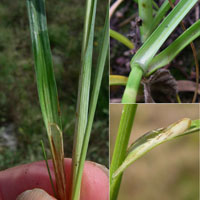
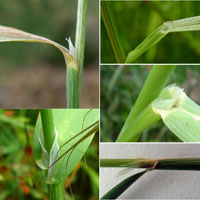
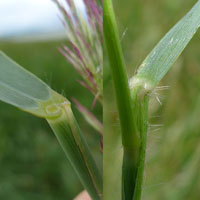
Ligule - In Asteraceae refers to individual flat flower in the flower 'head' as in Dandelions
Linear - Leaves are linear when they are long and narrow with +/- parallel sides
Lobed - Leaves (or petals) are lobed when edges are scalloped into larger protrusions or 'lobes', often irregular with bigger gaps between them than for 'teeth', but not divided to midrib
Local - Uncommon and only found in a few places
M/N
"Monocot" - Plant whose seeds have only one embryonic leaf or cotyledon (e.g. grasses and lilies) - leaf veins are (usually) parallel not branching
"Nectary" - A small organ (e.g. on a petal) producing nectar.
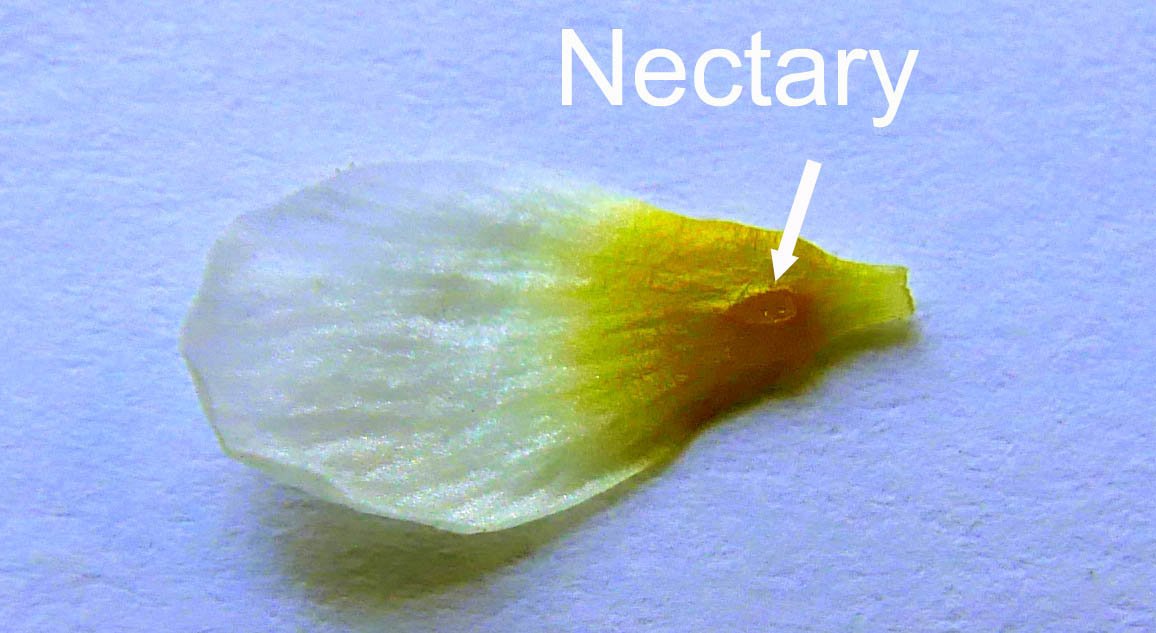
O
Opposite - Pairs of leaves come out at each node
Oval - Oval leaves are approximately elliptical - can vary from c.6x as long as broad to nearly round
Ovate - Leaves are ovate if they are oval but generally narrowing at base and tip
P/Q
Palmate - Leaves are palmate if divided into several leaflets all arising from the top of the leaf stalk (like a hand or digitate); may also be palmately lobed and shallowly or deeply dissected; (if only 3 leaflets usually termed ternate)
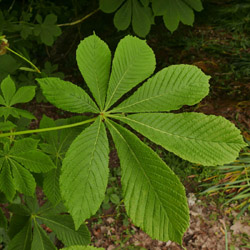
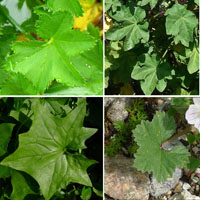
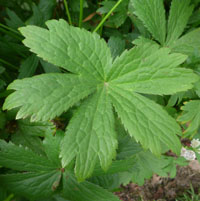
Panicle - A compound or much branched inflorescence of flowers
Pappus - A ring of hairs or scales, often enlarging in fruit, at the top of the developing fruit for each floret in Asteraceae

Parasite - A plant that derives its nutrition from attachment to another plant (often underground); usually without chlorophyll or green leaves
Patent - Applies to hairs, etc. sticking out at right angles
Pedicel - The stalk of a single flower
Peduncle - The stalk of an inflorescence
Perfoliate - A leaf that encircles the stem
Petal - The usually coloured (showy) inner whorl of a flower
Petiole - The stalk of a leaf
Phyllary - Bract surrounding flower head (=involucre) of Asteraceae
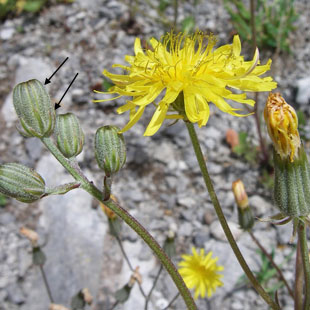
Pinna - Primary division of pinnate leaf in ferns (see under pinnate)
Pinnate - Leaves are pinnate if they are compound having one long axis with leaflets subtended off it. Doubly pinnate leaves (= 2-pinnate) have each of these side leaflets further pinnately divided into pinnules; 3-pinnate leaves are further divided
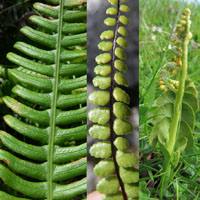
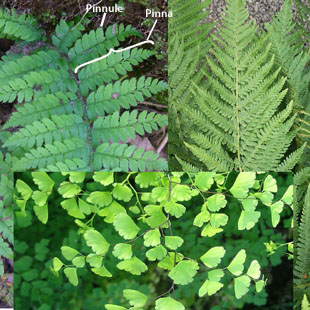
Pinnule - Final, smallest leaflet of a fern (see under pinnate)
Pollinia - Large pollen-bearing structures (usually in pairs) in orchids and some other genera.
R
Raceme - Spreading flowering shoot (=inflorescence) with the stalked flowers arising alternately. These can be "terminal" (at the end of shoots) or "axillary" (arising from leaf axils)
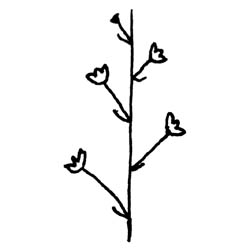
Rhachis - Stalk or mid-rib of leaf
Reflexed - Petals or sepals are 'reflexed' if they bend back on themselves
Regular - Flowers are 'regular' if they have all petals the same size and shape and hence >1 plane of symmetry (= 'actinomorphic')
Rhizome/Rhizomatous - having underground runners
Rushes - " are round"
S
Sagittate - Sagittate leaves are shaped like an arrow-head

Saprophyte - Plants that do not have chlorophyll or photosynthesise; they derive nourishment from decaying materials
Scarious - Tissue that is thin and papery, not green, often semi-transparent
Sedges - "Have edges" (and generally) triangular stems
Sepal - One of the segments of the outer whorl (calyx) of a flower; usually green but sometimes coloured like the petals
Septa - Dividing membrane, e.g. in leaves of rushes
Serrate - With sharp teeth pointing to apex (of leaf)
Sessile - Without stalks
Simple - Leaves are "simple" if not compound - i.e. divided to midrib
Sorus (pl. sori) - A group of sporangia in ferns
Spadix - A solid club-shaped organ containing the densely-packed minute flowers of an Arum usually partly enclosed by a papery leaf-like structure the spathe
Spathe - A papery leaf-like structure in Arums that partially encloses the solid club-shaped organ containing the densely-packed minute flowers of an Arum
Spathulate - Spoon-shaped
Spike - An inflorescence where the individual flowers or spikelets are densly arranged and unstalked
Spikelet - The individual group of flowers (with individual florets) in grasses and sedges (see diagram under
"grass")
Sporangia - The fruiting bodies of ferns that carry the spores
Spore - The reproductive cells of ferns (they are haploid having only half the usual number of chromosomes)
Spur - A spur of a flower is a tubular extension, usually from the corolla, that contains nectar
Stamen - The male part of a lower, bearing Anthers
Standard - The upper petal of a pea flower (Fabaceae)
Stigma - The apical pollen receptor (the female part) in the centre of a flower
Stipule - A pair of appendages, sometimes leaf-like, at the base of a leaf or its petiole
Stellate - Stellate hairs branch into star shapes
Stipe - The stem of a fern
Stipule - Structure at base of a leaf (see e.g. from Fabaceae)
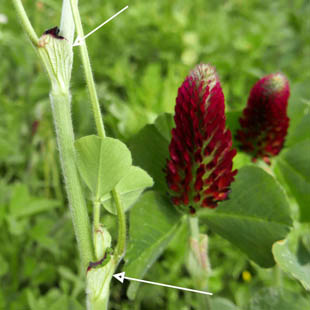
Stolon - Above ground 'runner'
Style - Structure supporting a stigma in a flower
Succulent - Leaves are succulent when they are thick and often spongy - frequently in salt habitats
Subspecies - One of several forms of a species (subsp.)
Superior - Ovary (and fruits) above the calyx
T
Tepal - Description for one of the flower segments when petals and sepals are similar (e.g. lilies, rushes, etc.)
Ternate - Divided into three
Tiller - The subsidiary shoots in grasses
Toothed - Leaves are toothed where they have small, regular 'teeth' along the edge
Truncate - Leaf base or tip is truncate if it goes straight across
U/V/W/X/Y/Z
Umbel - Inflorescence where all the flower stalks (pedicels) arise from one point
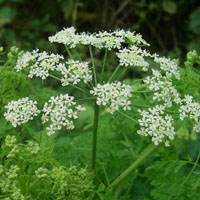
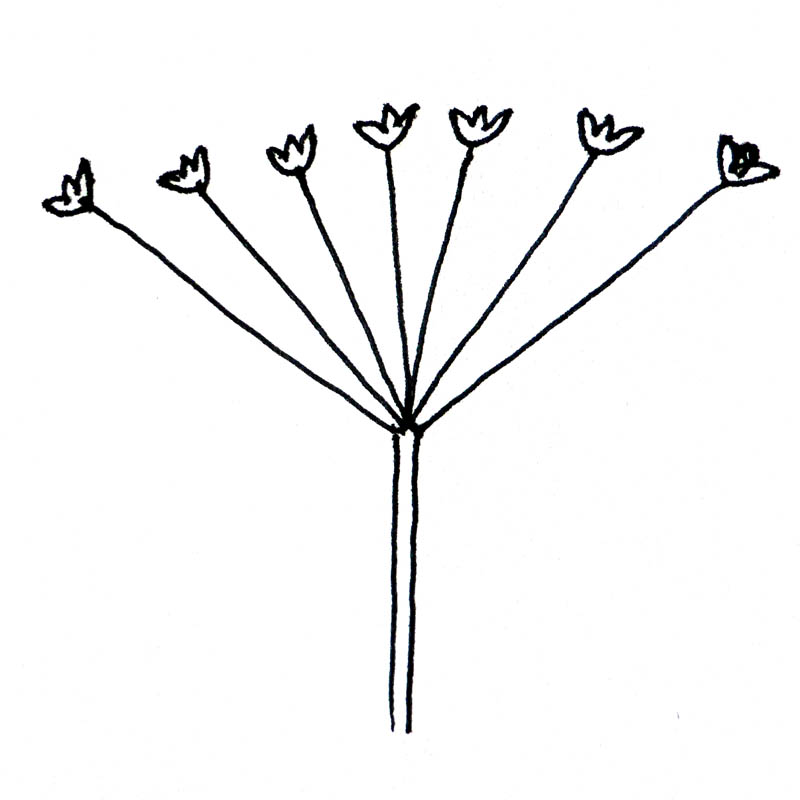
Utricle - Individual apparent 'fruit' of a sedge
Valve - In some species (e.g. in Brassicaceae) the fruits open by two separate 'Valves'
Vascular bundle - The conducting tissue in a leaf or stem, usually apparent as a thicker vein
Viviparous - Proliferating to produce plantlets from the flowers or fruits
Whorl - More than two (e.g. leaves) arising at a node
Wings - The side petals of a pea flower (Fabaceae)
Zygomorphic - Irregular flower not radially symmetric but usually with 1 plane of symmetry




















